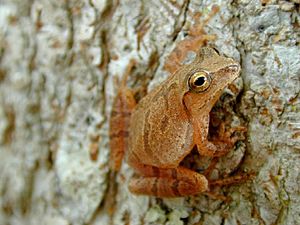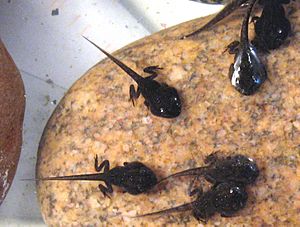Spring peeper facts for kids
The spring peeper (Pseudacris crucifer) is a small frog that lives across the eastern United States and Canada. They get their name from their loud, chirping call, which sounds like "peep, peep, peep!" and is one of the first signs that spring has arrived.
There are two main types, or subspecies, of spring peepers:
- The northern spring peeper (P. c. crucifer) is found all over the eastern United States and eastern Canada.
- The southern spring peeper (P. c. bartramiana) lives along the southern Gulf Coast, from southeastern Texas to northern Florida and southern Georgia. This type has a strong dark mark on its belly.
Quick facts for kids Spring peeper |
|
|---|---|
 |
|
| Conservation status | |
| Scientific classification | |
| Synonyms | |
|
Contents
What Do Spring Peepers Look Like?
Spring peepers are small frogs, usually tan or brown. They have a dark mark on their back that looks like an "X". This "X" is why they are called crucifer, which means "cross-bearer" in Latin. Sometimes, this mark can be hard to see.
These frogs are very tiny, growing to be less than 25 mm (0.98 in) to 38 mm (1.5 in) long. They weigh only about 3 and 5 g (0.11 and 0.18 oz), which is lighter than a single grape!
Special Body Features
Spring peepers have large toe pads that help them climb. Even though they can climb, they usually prefer to stay on the ground among fallen leaves and branches in the forest.
Their skin can be different shades like tan, brown, olive green, or gray. Female peepers are usually lighter in color. Male peepers are a bit smaller and often have dark throats. All spring peepers have a pale yellow color on the inside of their thighs.
Only male spring peepers can make the loud peeping sound. They have a special vocal sac under their throat that blows up like a balloon when they call. This sound helps them attract female peepers.
Where Do Spring Peepers Live?
Spring peepers mostly live in forests and growing woodlands. They need to be near temporary or semi-permanent wet areas like marshes, ponds, or swamps. These wet places are important because their eggs and tadpoles need water to grow.
Surviving the Cold
In colder northern areas, spring peepers sometimes face freezing temperatures during their breeding season. But don't worry, they have a special ability! They can survive even if some of their body fluids freeze. They hibernate under logs or behind loose tree bark to stay safe. They can even survive temperatures as low as -8 °C!
These frogs often gather in large groups, sometimes hundreds of them, to breed. They use many small wet areas, including swamps, temporary pools, and even human-made places like farm ponds.
Geographic Range
The southern spring peeper lives along the Gulf Coast, from southeastern Texas to southeastern Georgia and northern Florida. The northern spring peeper is found throughout the entire United States east of the Mississippi River and extends into eastern and central Canada.
How Spring Peepers Behave
What Do They Eat?
Spring peepers are nocturnal, meaning they are active at night. They are insectivores, which means they eat insects. They come out at night to hunt for small bugs like beetles, ants, flies, and spiders. They don't climb high into trees to hunt; instead, they look for food in low plants.
Spring peepers that live in deep, damp forests hunt both day and night. However, those living at the edges of woodlands usually hunt only at night.
Young spring peepers, called tadpoles, eat algae and other tiny living things in the water. Some animals that hunt spring peepers include great diving beetle larvae (when the peepers are tadpoles), snakes, skunks, and larger frogs.
Their Special Calls
As their name suggests, spring peepers make a very high-pitched call. It sounds a bit like a young chicken, but much louder and with a slightly rising tone. They are among the first frogs to start calling in the spring, right after the ice melts on wet areas.
When many peepers call together, it sounds like sleigh bells! The males usually call from the edges of the water where they breed. They hide near the bottom of bushes or grasses, making them hard to spot even when they are calling loudly.
Sometimes, if there are too many male frogs in one place, they will make an "aggressive call." This call is a rising trill, which is a fast, vibrating sound.
Life Cycle and Reproduction
Spring peepers breed at different times depending on where they live. In southern areas, they breed from October to March. In northern areas, they breed between March and June, when warm rains begin.
A female spring peeper usually lays about 900 eggs at a time, but she can lay up to 1000! The egg clusters are hidden under plants or debris at the bottom of the water. After the eggs hatch, the young peepers stay as tadpoles for two to three months. Then, they change into frogs and are ready to leave the water.
Female peepers choose their mates based on how fast and loud the male's calls are. Older, larger males tend to have faster and louder calls, which females prefer. Some male peepers, called 'satellite males', don't call themselves. Instead, they wait near loud males and try to get the attention of females who are attracted by the loud calls.
Spring peepers can live for about three years in the wild.
Conservation Status
For the most part, the spring peeper is a common and widespread frog in eastern regions. It does not have a special conservation status in many areas. However, their homes are changing quickly because wetlands are being lost. In some places, the number of spring peepers has gone down a lot.
The species is listed as threatened in both Iowa and Kansas.
| Wikisource has the text of the 1920 Encyclopedia Americana article Peeper. |
See also
 In Spanish: Pseudacris crucifer para niños
In Spanish: Pseudacris crucifer para niños
Images for kids






